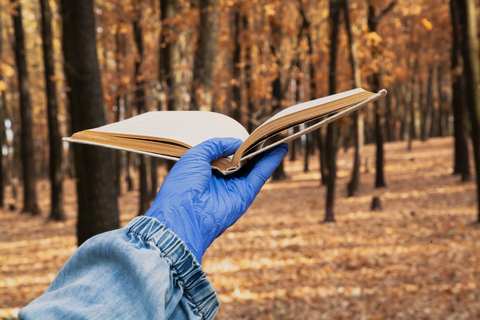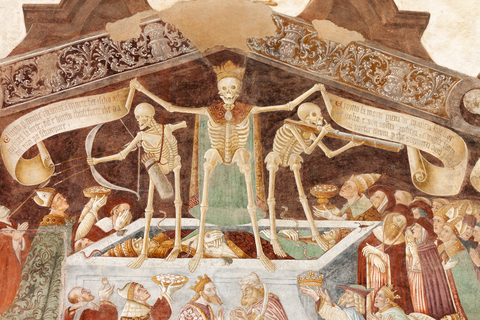
Around this time last year, just when The Virus was working its way towards pandemic status, certain books started to raise their public profile quite dramatically. None more so than Albert Camus’s La Peste and Daniel Defoe’s Journal of the Plague Year. Their covers were strikingly unblemished, and all the more visible across the ever less crowded train carriages. Their readers were devouring them as if they were nothing less than survival manuals.
Though Defoe’s account was only published fifty-seven years after the Great Plague of 1665, it was consequently better researched and informed than Samuel Pepys’s Diary entries at the time of the outbreak. Camus’s 1947 novel may be technically fictitious, but much of its source material derives from the plague which had swept through the French Algerian town of Oran a century before. Being, famously, one of a body of twentieth century authors labelled existentialist, Camus’s main preoccupation was that of the individual’s power, or lack of it, in the face of such epidemic forces majeures.
In this respect it spoke directly and urgently to the reading public of 2020. So too did the poetry born of pestilence over the past millennium and more, and if there was less public evidence of this, one reason was that relevant pieces were generally to be found in volumes that did not wear the word Plague on their sleeves. Yet there’s a profusion of the stuff, and its coming to light these past twelve months has been a double revelation, showing not only the quality of some lesser known authors’ work but also, more prosaically, the sheer frequency of public health catastrophies.
Take Shakespeare. In 1564, the year of his birth in Stratford-upon-Avon, about a quarter of the town’s population died from the plague. Twenty-eight years later, when he was living and working in London, an outbreak closed the city’s theatres for months on end. Turning the lockdown to advantage, he wrote his poem Venus and Adonis, which did wonders for his career.
For most of the seventeenth century’s first decade, and into the second, the Globe and other theatres in the capital were closed for a total of almost eighty months. Looking for plague-free locations, Shakespeare’s company started to forge links with such provincial towns as Coventry, Shrewsbury and Bath.
Just as sickness and sudden death became commonplace, so, inevitably, did the imagery of pestilence littering the author’s lines. Hence the dying Mercutio’s willing “a plague on both your houses” to the feuding Capulets and Montagues in Romeo and Juliet would have carried a hideously visceral charge. Likewise King Lear’s declaring to his daughter Goneril, “Thou art a boil”; or Coriolanus’s graphic cursing of the plebeians: “Boils and plagues/Plaster you o’er, that you may be abhorred/Farther than seen, and one infect another/Against the wind a mile!”
Go back a further two centuries and we find an England reeling first from the effects of the Great Famine brought about by a chronic grain shortage, and later by The Black Death, which is reckoned to have carried off about half of the country’s population. Death truly became a way of life. It brought in massive demographic shifts; a falling-away of once great monastic houses; land clearances which the weakened rural communities were unable to oppose. Later commentators note the prehistory of enclosure, Reformation and the end of English society’s three-way division of nobility, clergy and peasantry.
There was no way that poets as astute as Geoffrey Chaucer, his friend John Gower, and William Langland, author of the politically observant Vision of Piers Plowman , could let the time’s upheavals pass unscrutinised. Through his presentation of death as a protagonist in his Pardoner’s Tale, Chaucer springs the bold, controversial trick of suggesting that the plague is only interested in taking the lives of those whose ways have fallen into the abyss of immorality.
Whether or not he believed that to be the case, he was recognising a tradition of scapegoating which stretched from Pharoah’s enslavement of the Hebrews and which was to continue unabated into our own times with the blaming of HIV-AIDS on the gay community.
Plague imagery gets everywhere. Thanks to a famous nursery rhyme it is even embedded in the sounds of our own infancy. Ring a Ring o’ Roses, referring to the illness’s blotchy red sores, didn’t appear in print until 1881, but it had been hanging around for centuries in oral form, with its innocent chime harbouring the dark reality of pocketfuls of posies that masked the stink of the sickness from which all fell down.

Let’s not forget Eyam, and let’s be grateful to Simon Armitage for doing as Laureates are meant to at such times by reminding us, in verse, of that Derbyshire village’s extraordinary story. It was to this small rural community that a bale of cloth had arrived from the plague-stricken capital in 1665. When the damp fabric was dried at the hearth by a tailor’s assistant called George Viccars, out swarmed the infection-laden fleas. With social distancing being a concept of the far future, whole families were succumbing to the lethal Yersina pestis bacterium within days.
The newly installed rector William Mompesson, enlightened but controversial, persuaded the population to quarantine itself so that the infection could not spread beyond the confines of the village. It was nothing if not an act of self-sacrifice, and in the course of just over a year one third of the village’s population of eight hundred were dead. Those who survived were aided by deliveries of food from outlying neighbours, including The Duke of Devonshire at Chatsworth House. Goods were paid for with coins left at the village boundaries in troughs of vinegar, thought to be disinfectant.
I only became aware of Eyam’s self-sacrifice a few years ago while walking in the Peak District. Now, during lockdown, I wondered whether the events had been memorialised in poetry. Armitage, who lives and writes in Marsden, up at the northern end of the Peak, had indeed gone into verse. The result is an apparently plain-dealing piece called Lockdown, which turns out to be a subtle pairing of dreamt reflections on love and boundaries with, at its heart, the real and tragic instance of a local couple, Emmott Sydall and Rowland Torre, thwarted by the quarantine line.
Not that Eyam escaped the determined embrace of Victorian sentiment. This is how the tragedy was revisited in Mary Howitt’s robust measures: “Oh! Piteous was it then that place to tread,/ Where children played and mothers had looked on….O’er each bright cottage hearth death’s darkness stole;/Tears fell, pangs racked, where happiness had shone.”
What of AIDS? Does it count as a plague? Perhaps only purists would deny it such status on technical grounds. Its treatment and survival rates have improved vastly since the onset of the pandemic in 1981, and yet in 2017 data produced by the US-based Foundation for AIDS Research showed that nearly 37 million people worldwide were living with HIV.
What cannot be questioned is that the ubiquity of the illness produced an enormous outpouring of poetic response. Some of this was marked by an understandable defiance in the face of homophobia, but the predicaments it produced also gave rise to work of sublime candour and tenderness by authors who felt, well, plagued. Among the finest of these was Thom Gunn, British-born but resident in the US for almost all his adult life. He is best known for his 1992 poem, The Man With Night Sweats (and collection of the same name). It focuses unsparingly on a man who has developed AIDS symptoms, and it is one of seventeen elegies he wrote in response to the loss of close friends.
So where are the Covid poems? The answer is: where are they not? The web is groaning beneath their weight. Surely you’ve noticed. Not just poems brought on by the crisis, but poems to help you through it. Poems of hope, poems of endurance, poems of encouragement, poems of consolation.
You catch me fresh from the National Poetry Library’s website. It is bursting and bountiful with matter as fresh as the spring. It’s almost, but not quite, enough to make you reckon that where there’s death, there’s hope. There’s ruminative and rueful, passionate and pacifist. Here is Christina Rossetti saying “Hurt no living thing,” and Pascale Petit saying “I have cleaned the window of my self until I gleam.” There’s also a poem called At The Beginning of Covid-19, which concludes with the line: “Nothing’s touching me anymore, and the spring rain is peace.” I get it.
I’ve been at it myself, and maybe you have too. Do switch off now if you want, I shan’t be offended. Here it is anyway. I hope it speaks for itself, and if doesn’t, there’s something wrong with it. I wrote it an eternity ago – like, six or even seven weeks, when we were being told to not talk in case we infected someone; or to not breathe in case we took in some dodgy air. Something like that. (Bleaklow, by the way, is the highest bit of ground in the Dark Peak in Derbyshire, not all that far from Eyam as it happens.)
VALLEY OF BREATH
In a time of consonants kept caged,
And sentries put on point to stop and fine
Abusers of the new Percussive Quotas,
Ps and Qs for short;
When even vowels are agents of contagion,
Words huddle in the attic of the mind
And in this close confinement come to court
The liberty of thought.
The outside opens up. The terraced tiers
Are all of limestone pavement, and the towers
Are Kinder and its kindred in the Peak.
The built valleys of death
Evaporate, and in their place appear
The moorland gradients and the wind’s old choirs;
The ways across the swallowing bog, then Bleaklow’s
Gathering point of breath.
ends

To have the mind opened up by such a fascinating piece, to let a poem in – a beautiful one at that – is a real treat. Thank you
Thank you so much, Alan and Dave. Am in total agreement about plague/covid poems – a real need to react, process, express, stay sane. Here’s a lockdown one of mine from a bleak, unvaccinated day in March 2021:
Another day in the waiting room
Reading a screen, reading a book
Waiting for the train I cannot catch yet.
There are still trains on TV
There are trains that cross the viaduct
Empty, or almost empty,
Over the road where the little cars
Run with their windows shut.
One day, I shall be safe and authorised.
One day we all will leave the waiting room.
One day the train door will open
And inside, outside,
Life will be there
Waiting.